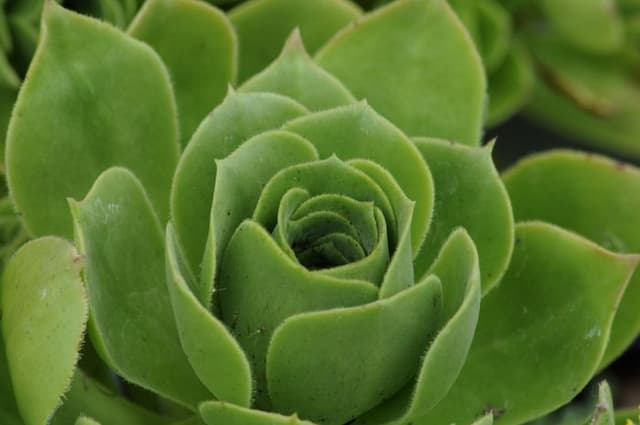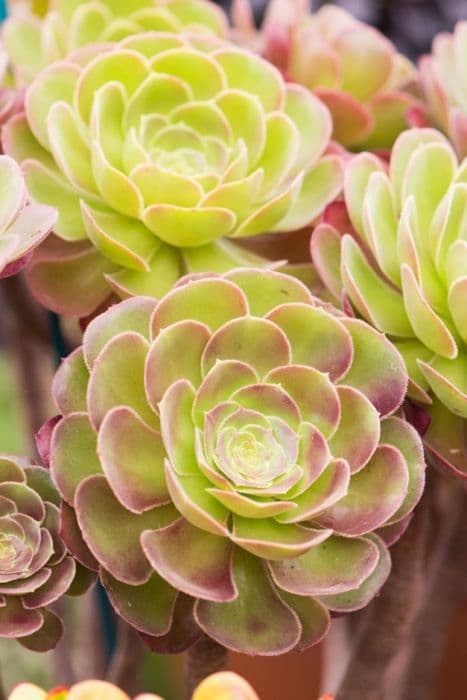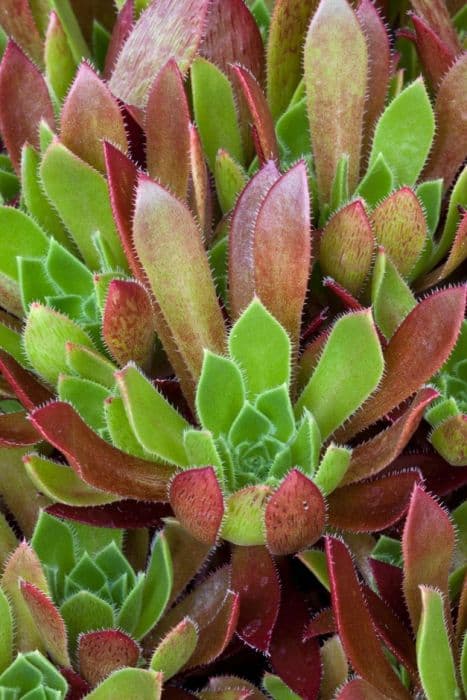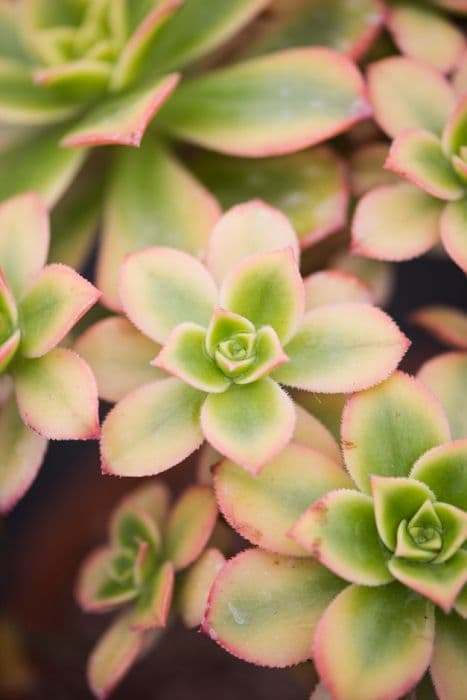String of Buttons Crassula perforata

ABOUT
The plant known commonly as String of Buttons is an attractive succulent with a very distinctive appearance. It is characterized by stacked, fleshy leaves that spiral around the stem, creating a pattern akin to a string of buttons or coins, which gives it its common name. These leaves are often a pale green in color and can have edges tinged with pink or red, adding to the decorative appeal of the plant. The leaves themselves are typically small, flattened, and slightly triangular, and as they spiral around the stem, they form compact columns that contribute to the dense and textured look of the plant. The overlapping nature of the leaves gives the impression of intricacy and detail, reminiscent of some sort of living sculpture. During certain times of the year, String of Buttons may produce flowers. These blooms are generally small and inconspicuous compared to the bold statement of its foliage. The plant's overall appearance is one of structured playfulness, combining the ordered arrangement of its leaves with a succulent's classic robust and drought-tolerant characteristics. It is quite a versatile plant, often used in container gardens, as ground cover, or in rock gardens where its geometry can be showcased amidst other plant varieties.
About this plant
 Names
NamesSynonyms
String Of Buttons, Necklace Vine, Pagoda Plant, Stacked Crassula
Common names
Crassula conjuncta, Crassula nealeana, Crassula perfossa.
 Toxicity
ToxicityTo humans
The common name for Crassula perforata is String of Buttons. This plant is not considered toxic to humans. However, it is advisable to avoid ingestion as it is not a food item, and consuming non-edible plants may sometimes cause mild stomach upset or an allergic reaction in sensitive individuals.
To pets
String of Buttons is not toxic to pets such as cats and dogs. It is generally considered safe around animals, but ingestion of large amounts can potentially cause gastrointestinal discomfort or an upset stomach due to the plant not being a normal part of an animal's diet.
 Characteristics
CharacteristicsLife cycle
Perennials
Foliage type
Evergreen
Color of leaves
Green
Flower color
Yellow
Height
1-2 feet (30-60 cm)
Spread
1-2 feet (30-60 cm)
Plant type
Succulent
Hardiness zones
9
Native area
South Africa
Benefits
 General Benefits
General Benefits- Easy to care for: Crassula perforata, commonly known as String of Buttons, is a low-maintenance plant ideal for beginners.
- Drought-tolerant: Being a succulent, it requires minimal watering and can survive prolonged dry periods.
- Aesthetic appeal: With its stacked, triangular leaves and attractive growth pattern, String of Buttons adds visual interest to any space.
- Versatile decor: It can be used in various forms of indoor decoration, including terrariums, hanging baskets, and as a tabletop plant.
- Propagation ease: The plant can be easily propagated from cuttings, making it simple to expand your collection or share with friends.
- Compact size: Its small size makes it perfect for growing in limited spaces such as apartments and offices.
- Non-toxic to pets: String of Buttons is generally considered safe around pets, reducing the worry of accidental ingestion.
 Medical Properties
Medical PropertiesThis plant is not used for medical purposes.
 Air-purifying Qualities
Air-purifying QualitiesThis plant is not specifically known for air purifying qualities.
 Other Uses
Other Uses- Miniature Gardening: Crassula perforata, commonly known as String of Buttons, can be used to create a tiny, low-maintenance garden as its small size and sculptural form work well in fairy gardens and tabletop arrangements.
- Photography Prop: The geometric shape and interesting texture of String of Buttons can serve as a unique prop for close-up photography or as a subject in botanical photography.
- Educational Tool: Botany enthusiasts or teachers can use String of Buttons to demonstrate plant propagation techniques such as leaf cutting or stem cutting in educational settings.
- Artistic Inspiration: Artists may draw inspiration from the plant's symmetrical leaf arrangement and use it as a basis for patterns, textures, and forms in various art mediums.
- Jewelry Making: Dried or cast leaves of String of Buttons can be used in making botanical-themed jewelry, such as resin pendants or earrings.
- Wedding Decor: The elegant and unique appearance of String of Buttons makes it a popular choice for use in bouquets, centerpieces, or as table decorations in eco-friendly or succulent-themed weddings.
- Culinary Presentation: While the plant is not edible, its leaves can serve as an aesthetic garnish for plating and presenting dishes in upscale restaurants or culinary shows.
- Stress Relief: Caring for a String of Buttons plant, like other forms of gardening, can be a therapeutic activity that helps reduce stress through the nurturing of plants and connection with nature.
- Cosplay and Costume Design: The rosette patterns of the String of Buttons could inspire and be incorporated into design elements for costumes, especially for nature-themed or fantasy characters.
- Corporate Gifting: As a low-maintenance and attractive desk plant, String of Buttons can be used as a corporate gift to enhance the work environment or as part of a green initiative in offices.
Interesting Facts
 Feng Shui
Feng ShuiThe plant commonly known as String of Buttons is not used in Feng Shui practice.
 Zodiac Sign Compitability
Zodiac Sign CompitabilityString of Buttons is not used in astrology practice.
 Plant Symbolism
Plant Symbolism- Perseverance and Resilience: Often known as "String of Buttons," Crassula perforata is a hardy succulent that can thrive in conditions where other plants might struggle, symbolizing the ability to endure and flourish despite challenges.
- Wealth and Prosperity: Like many succulents, the String of Buttons is associated with wealth in feng shui, as their plump leaves can be reminiscent of coins, symbolizing the accumulation and retention of wealth.
- Friendship and Community: The way String of Buttons grows in clusters with its leaves stacked upon each other can symbolize strong social connections and the importance of friends and family in one's life.
- Protective Energies: Succulents in general are considered to embody protective qualities, with the String of Buttons often included in this category, symbolizing a shield against negative forces.
 Water
WaterThe String of Buttons should be watered deeply but infrequently. You should water this succulent only when the top inch of soil feels dry to the touch, which typically means watering approximately every 1 to 2 weeks, depending on the climate and indoor conditions. Use enough water so that it runs out of the drainage holes at the bottom of the pot, indicating that the soil is fully saturated. A good rule of thumb is to provide about 8-16 ounces (0.06-0.12 gallons) of water for a 6-inch pot each time you water, adjusting based on the size of the plant and pot.
 Light
LightString of Buttons thrives in bright, indirect light. The ideal spot for this succulent is near a window that receives plenty of sunlight throughout the day but is shielded from the harsh direct rays of the afternoon sun. A south-facing or east-facing window is often a good choice for optimal light conditions.
 Temperature
TemperatureString of Buttons prefers a temperature range between 60 to 75 degrees Fahrenheit. It can tolerate temperatures as low as 30 degrees Fahrenheit but should be protected from frost. Ideally, maintain a stable temperature without frequent fluctuations to ensure the best growth and health of the plant.
 Pruning
PruningPrune String of Buttons to maintain its shape and encourage fuller growth. Trimming can be done any time of the year, but it's best done in the spring or early summer when the plant is in its active growth phase. Remove any dead or damaged leaves, and snip off long stems as desired. Pruning every few months is sufficient, depending on the plant's growth rate and desired appearance.
 Cleaning
CleaningAs needed
 Soil
SoilString of Buttons prefers a well-draining soil mix, such as a blend of cactus potting mix with perlite or pumice added for extra drainage. The ideal soil pH for String of Buttons is between 6.0 and 6.5.
 Repotting
RepottingString of Buttons should be repotted every two to three years into fresh soil to prevent nutrient depletion and to allow for growing space.
 Humidity & Misting
Humidity & MistingString of Buttons thrives in average indoor humidity levels and doesn't require any special humidity adjustments.
 Suitable locations
Suitable locationsIndoor
Provide bright light and well-draining soil for String of Buttons.
Outdoor
Place in partial sun, protect from frost for String of Buttons.
Hardiness zone
9-12 USDA
 Life cycle
Life cycleThe String of Buttons (Crassula perforata) starts its life as a seed, which when planted in well-draining soil and given appropriate warmth and light, germinates to produce a small seedling. As the seedling grows, it develops a rosette of stacked, triangular leaves that spiral around the stem, exhibiting its characteristic pattern. The plant matures by forming stems that can grow vertically or trail as they lengthen, and it can propagate by producing offsets or from leaf cuttings that fall to the ground and root. During the right season, typically spring or early summer, it blooms, producing small, star-shaped flowers which are typically yellowish-white in color. After pollination, these flowers may produce seed capsules containing new seeds, thereby completing the reproductive cycle. Over time, with proper care and in ideal conditions, the String of Buttons can reach a mature size and may need to be potted up or trimmed to maintain shape and health.
 Propogation
PropogationPropogation time
Spring-Early Summer
String of Buttons, or Crassula perforata, can be easily propagated, with the ideal time for propagation being in the warmer seasons of spring through early fall. The most popular method of propagation for this succulent is through leaf or stem cuttings. To propagate from a stem cutting, one should select a healthy section of the stem about 2 to 4 inches long (5 to 10 cm), making a clean cut with sterilized scissors or knife. The cutting should then be allowed to callous over for a few days to prevent rotting when planted. After the end is calloused, the stem cutting can be placed in well-draining soil, watered sparingly until roots develop, usually seen in a few weeks. Once established, the new String of Buttons will gradually grow into a full plant, mirroring the parent's characteristics. Care should be taken not to overwater during this rooting period, as succulents are particularly susceptible to root rot due to excess moisture.









